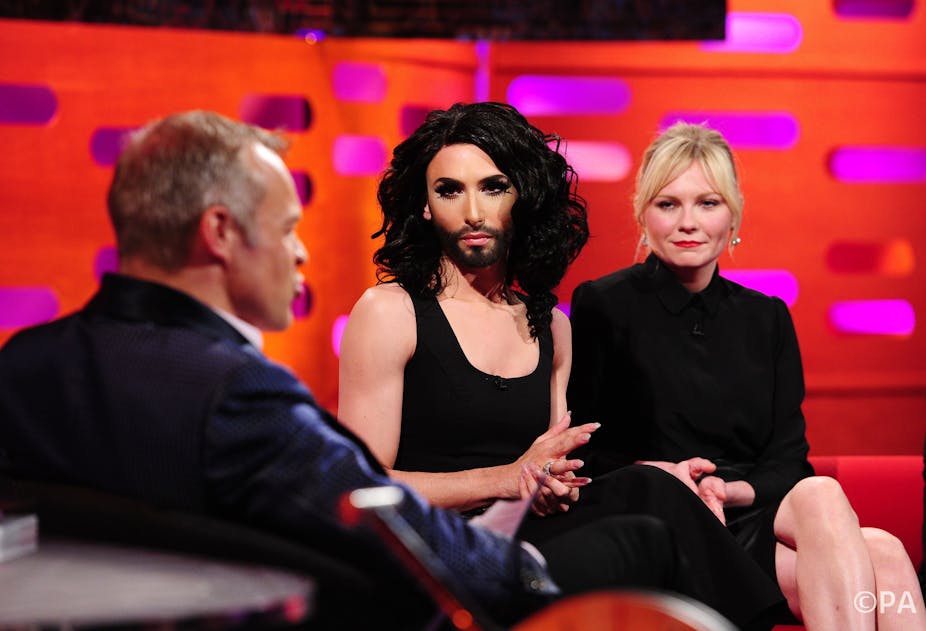“God save the Wurst: Conchita rockte London” – at least, so said the Austrian free newspaper Heute. Conchita Wurst continues to follow her Eurovision win with TV interviews and club openings, and is joining Ricky Martin and Leona Lewis this weekend to sing at the Life Ball, a charity fundraiser in Vienna.
Whether she is being hailed by her manager or condemned by Russian politicians, it is as a “bearded lady”.
But of course that isn’t exactly it: Conchita is a drag persona, and even that famous perfect black beard is not entirely the real thing, apparently darkened with eye shadow or perhaps enhanced with special fibres used in theatrical make-up.
Bearded ladies have long been the object of fascination. In the 19th century, at a time when medical writers were arguing that a beard has positive health benefits for men, bearded women were displayed in circuses and freak shows.

In the cartes-de-visite and cabinet cards produced to advertise these individuals, they were shown in demure clothing, sometimes doing feminine pursuits like sewing, and posed alongside flowers or with their children. The image gained its power to shock from the sheer normality of the female figure – apart from the full beard. Bearded ladies – and even the word “ladies” suggests their “respectability” – look out at the viewer, making eye contact, casually displaying their facial hair.
But earlier too, people were intrigued by women with beards. Medical writers from early modern Europe looked back to the ancient Greek doctor, Hippocrates, expecting that the “Father of Medicine” would surely have described everything that could possibly exist. In a treatise long associated with the name of Hippocrates – Epidemics, dating to the 4th century BC – they read about Phaethousa of Abdera, the wife of Pytheas.
The story goes that when her husband was away, she stopped menstruating, grew a beard and excess body hair, and her voice deepened. The ancient Greeks interpreted this as her menstrual blood being turned into hair. Before her husband left, she had been very fertile. One of the roles of a woman’s blood was to provide material from which a baby could grow. Sexual intercourse was thought to keep a woman’s body open, to move the blood around the body so it could come out once a month. Without a husband, Phaethousa could not lose her excess blood in the normal ways – menstruation or pregnancy.
During the Renaissance, medical writers interested in how women could grow beards looked back to this Hippocratic case history. Some doctors at the time still believed in spontaneous sex change from the female to the male, and they suggested that this was happening to Phaethousa. A build-up of excess heat in her body had made it more like a man’s body. But others disagreed. They pointed to the lack of a happy ending in the original story. Although the ancient doctors did everything they could to bring Phaethousa’s periods back, she died. This ending suggested that sex change could not happen, and that anyone apparently poised between a male and a female body could not survive.
Stories of bearded ladies seem to surface at times in history when gender roles are under debate. But they haven’t tended to go with a message of tolerance for those whose bodies are “different”, but instead are held up as a threat to those working for the rights of women, and are used to underline the importance of clearly defined gender roles. In 1910, when women were seeking the vote, an anti-suffrage postcard was produced showing a suffragette asking the bearded lady on display at a fairground: “How did you manage it?” The bearded lady has her travelling bag, her source of income as well as an image of her greater freedom.
This association between bearded ladies and women seeking the vote picked up earlier ideas, as seen for example in an anonymous contribution to the “Notes and Queries” section of the journal Natural Science in 1897:
One thing is still lacking to ‘the new woman’. It is a beard. But this, according to Dr A Brandt, she may hope to have in the course of some thousands, possibly hundreds, of years. Many women have beards already. Some take a pride in them, and utilise them as a source of income: others keep them in check by the use of depilatories, of forceps, or even a razor.
Real women with beards were fascinating, but a threat to the order of society. The bearded lady as a challenge is nothing new.

